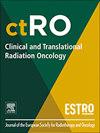外束放射治疗子宫内膜癌骨髓亚区放射剂量与急性血液学毒性的关系
IF 2.7
3区 医学
Q3 ONCOLOGY
引用次数: 0
摘要
目的探讨容量调节电弧治疗(VMAT-RT)子宫内膜癌急性血液学毒性(HT)的剂量学参数。方法回顾性选取2019年3月至2022年11月在我院接受治疗的子宫腺癌患者。所有患者均接受辅助外束放疗,包括体积调制弧线治疗(VMAT)策略和阴道袖带近距离增强治疗。当有指示时,术前或夹层手术后给予辅助铂基化疗。每位患者骨盆骨髓轮廓并分为三个亚位:腰骶棘(LSBM),髂骨(IBM)和下骨盆(LPBM)。收集10、20、30、40 Gy(分别为V10、V20、V30、V40)照射区域的体积和平均剂量(Dmean)。放疗期间血液学毒性按照CTCAE V 5.0分级。线性逻辑回归模型用于检验剂量学参数与高温疗法之间的关系。结果对99例患者的资料进行回顾性分析。辅助外束放射治疗采用体积调制弧线治疗(VAMT)策略,总剂量为45 Gy, 1.8 Gy/次,外加阴道袖带近距离治疗,总剂量为10 Gy,每周2次。31例患者在放疗期间出现HT≥2级。V20 Gy LSBM <;敏感性83.3%,特异性61.5%;在lt患者中,64%的患者发生2级或更严重HT的风险最高为20%。60岁;对于70岁以上的患者,毒性风险低于20%,独立于V20Gy LSBM的百分比体积(95% CI 0.60-0.87;p = 0.03)。血液学毒性与IBM和LPBM的V10-20-30-40或Dmean无相关性。涉及下骨盆的剂量学参数与血液学毒性的相关性比涉及髂骨的剂量学参数强,即使不显著。结论在这种情况下,剂量限制与年龄有关,可以降低HT的风险。低剂量放疗后的腰骶盆容积(V20 lshbm >;64%)似乎与年轻患者的HT有关;相反,在年龄超过70岁的患者中,V20Gy的LSBM百分比似乎与毒性风险无关。今后的调查应设法通过在规划过程中纳入这些参数来证实这些发现。本文章由计算机程序翻译,如有差异,请以英文原文为准。
Correlation between radiation dose to bone marrow subregions and acute hematologic toxicity inendometrial cancer treated with external beam radiotherapy
Aim
To identify dosimetric parameters associated with acute hematologic toxicity (HT) in endometrial cancer treated with volumetric modulated arc therapy (VMAT-RT).
Methods
Patients with uterine adenocarcinoma treated in our Institution from March 2019 to November 2022 were retrospectively enrolled in this study. All patients underwent adjuvant external beam radiotherapy with Volumetric modulated arc therapy (VMAT) strategy plus a brachytherapy boost on vaginal cuff. When indicated, adjuvant platin-based chemotherapy was administered after surgery in upfront or sandwich setting. Pelvic bone marrow was contoured for each patient and divided into three subsites: lumbosacral spine (LSBM), ilium (IBM) and lower pelvis (LPBM). The volume of each region receiving 10,20,30 and 40 Gy (V10, V20, V30, V40, respectively) and mean dose (Dmean) was collected. Hematological toxicity during radiotherapy treatment was graded according to the CTCAE V 5.0. Linear logistic regression models were used to test associations between dosimetric parameters and HT.
Results
Data from 99 patients were retrospectively analyzed. Adjuvant external beam radiotherapy was delivered to the pelvis with Volumetric modulated arc therapy (VAMT) strategy for a total dose of 45 Gy, 1.8 Gy/fraction plus a brachytherapy boost on vaginal cuff for a total dose of 10 Gy in 2 fractions weekly. Thirty-one patients developed during radiotherapy treatment an HT ≥ grade 2.
With a sensitivity of 83.3 % and specificity of 61.5 %, V20 Gy LSBM < 64 % is associated to a maximum 20 % risk of Grade 2 or worse HT in patients with < 60 years old; for patients older than 70, the risk of toxicity is below 20 % independently by the percentage volume of V20Gy LSBM (95 % CI 0.60–0.87; p = 0.03).
No association between hematological toxicity and V10-20–30-40 or Dmean of IBM and LPBM were observed.
Dosimetric parameters involving the lower pelvis had stronger association with hematological toxicity than those involving the ilium, even if not significant.
Conclusions
In this experience a dose constraint age-dependent was proposed, to reduce the risk of HT.
The volume of lombo-sacral pelvis receiving low-dose radiation (V20 LSBM > 64 %) seems to be associated with HT in younger patients; instead in older than 70 patients the percentage of V20Gy LSBM seems not correlate with risk of toxicity. Future investigations should seek to confirm these findings through the inclusion of these parameters in the planning process.
求助全文
通过发布文献求助,成功后即可免费获取论文全文。
去求助
来源期刊

Clinical and Translational Radiation Oncology
Medicine-Radiology, Nuclear Medicine and Imaging
CiteScore
5.30
自引率
3.20%
发文量
114
审稿时长
40 days
 求助内容:
求助内容: 应助结果提醒方式:
应助结果提醒方式:


